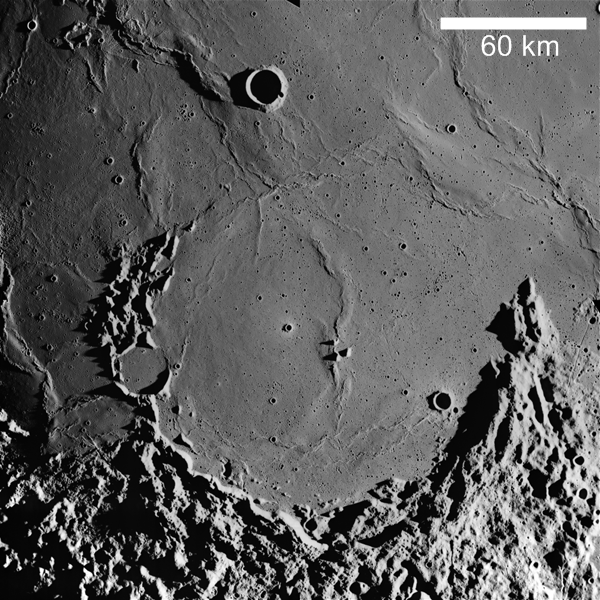
| Project Home | About the Scans | Browse Gallery | Image Map | Support Data | Resources | Ephemeris |
Featured Image - 03/10/2009
Letronne Crater: Plunging Into the Ocean of Storms
Letronne Crater is nestled on the southwestern edge of Oceanus Procellarum (Figure 1). The southern half of the crater rim is exaggerated by a sharp highlands-mare contact, while the northern half of the rim seems to plunge beneath the Procellarum mare. This abrupt northern boundary suggests faulting may have lowered the northern portion of the crater before the mare lavas were erupted (Masursky et al., 1978).
Figure 1. Letronne Crater in southwest
Oceanus Procellarum (Apollo Image AS16-M-2995 [NASA/JSC/Arizona State
University]).
Spectroscopic studies of Letronne's remaining ejecta show that the ejecta from Letronne is a mix of highlands and mare materials (Hawke et al., 1993; Mustard and Head, 1996). The implication is that both highlands and mare materials were already present in the target area when the crater was formed. Dark-haloed craters to the southwest of Letronne (not shown) suggest that the highland materials on the southern edge of the crater and in the region between the southern tip of Oceanus Procellarum and Mare Humorum are relatively thin and overlie a cryptomare layer. Cryptomare, or hidden mare, are formed when a thin blanket of highland material is thrown on top of mare material. As impacts later form, they punch through the thin blanket of highland ejecta and expose darker mare to the surface.
In the future, data returned by ongoing and future lunar missions, such as the Lunar Reconnaissance Orbiter, will be used to study the Letronne region in order to help lunar scientists increase our understanding of both lunar tectonism and lunar volcanic processes.
References
Apollo
Over the Moon: A View from Orbit (1978) H. Masursky, G. W. Colton,
F. El-baz, eds. NASA SP-362.
B. R. Hawke, et al. (1993) Remote Sensing Studies of the Terrain
Northwest of Humorum Basin, Geophysical Research Letters,
20:419-422.
J. F. Mustard and J. W. Head (1996) Buried Stratigraphic Relationships
Along the Southwestern Shores of Oceanus Procellarum: Implications for
Early Lunar Volcanism, 101:18,913-18,925.
Tweet
![]()

|
|
Space Exploration Resources |
|
 LPI LPI
|
